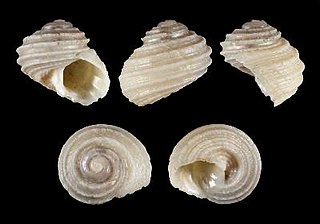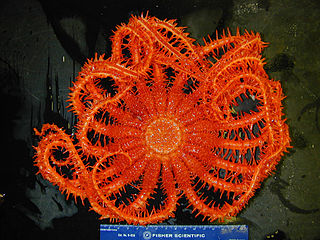A Ramsar site is a wetland site designated to be of international importance under the Ramsar Convention.

The Arcoida is an extant order of bivalve molluscs. This order dates back to the lower Ordovician period. They are distinguished from related groups, such as the mussels, by having a straight hinge to the shells, and the adductor muscles being of equal size. The duplivincular ligament, taxodont dentition, and a shell microstructure consisting of the outer crossed lamellar and inner complex crossed lamellar layers are defining characters of this order.

Homalopoma, common name the dwarf turbans, is a genus of mostly very small sea snails with a calcareous operculum, marine gastropoda molluscs in the family Colloniidae.

Axinellidae is a family of sponges in the order Axinellida.

The Brisingids are deep-sea-dwelling starfish in the order Brisingida.
Murchisonellidae is a taxonomic family of sea snails, marine opisthobranch gastropod mollusks in the superfamily Murchisonelloidea.

Hexaplex is a genus of medium-sized to large sea snails, marine gastropod mollusks in the family Muricidae, the murex shells or rock snails.

Aplysina archeri is a species of tube sponge that has long tube-like structures of cylindrical shape. Although they can grow in a single tube, they often grow in large groups of up to 22 tubes. A single tube can grow up to 5 feet (1.5 m) high and 3 inches (7.6 cm) thick. These sponges mostly live in the Western Atlantic Ocean: the Caribbean, The Bahamas, Florida, and Bonaire. Like most sponges, they are filter feeders; they eat food such as plankton or suspended detritus as it passes them. Very little is known about their behavioral patterns except for their feeding ecology and reproductive biology. Tubes occur in varying colors including lavender, gray, and brown. They reproduce both by asexual and sexual reproduction. These sponges take hundreds of years to grow and never stop growing until they die. Snails are among their natural predators. The population density of these sponges is going down because of oil spills and other pollution.

Schilderia is a genus of sea snails, marine gastropod mollusks in the family Cypraeidae, the cowries.
Cycloscala is a genus of predatory sea snails, marine prosobranch gastropod mollusks in the family Epitoniidae, commonly known as wentletraps.
Auriculigerina is a genus of medium-sized sea snails, marine gastropod mollusks in the family Eulimidae.
Bacula is a genus of medium-sized sea snails, marine gastropod mollusks in the family Eulimidae.
Bacula lamberti is a species of sea snail, a marine gastropod mollusk in the family Eulimidae. The species is one of three known species to exist within the genus Bacula, the other two being Bacula morisyuichiroi and Bacula striolata.
Batheulima abbreviata is a species of sea snail, a marine gastropod mollusk in the genus Batheulima, a minor genus within the family Eulimidae.
Bulimeulima magna is a species of medium-sized sea snail, a marine gastropod mollusk in the family Eulimidae. The species is one of two known species to exist within the genus Bulimeulima; the other congener is Bulimeulima incolorata.

Amphipholis squamata, common names brooding snake star and dwarf brittle star, is a species of brittle star in the family Amphiuridae.
Murchisonella is a genus of sea snails, marine gastropod mollusks in the family Murchisonellidae, the pyrams and their allies.

Verongida is the name of an order of demosponges within the phylum Porifera. The "skeleton" in these sponges is made up of spongin, rather than of spicules. They live in marine environments.
Verongula is a genus of demosponges in the family Aplysinidae.








